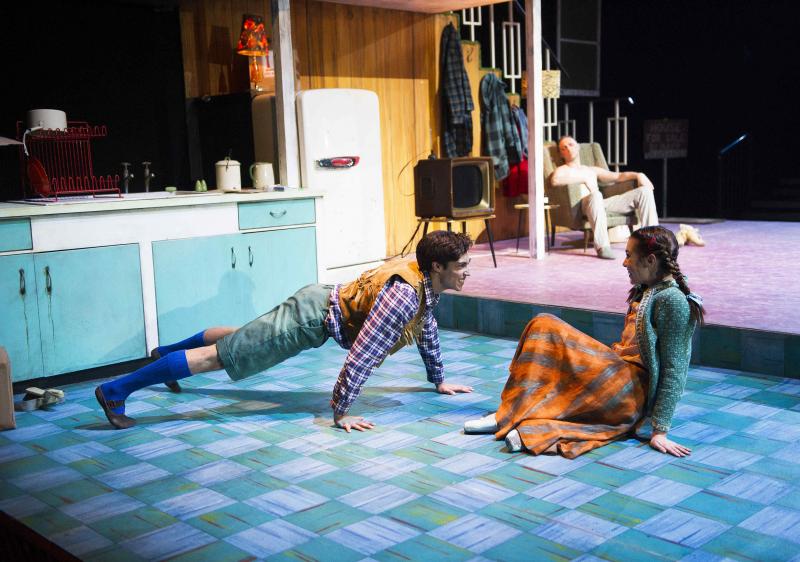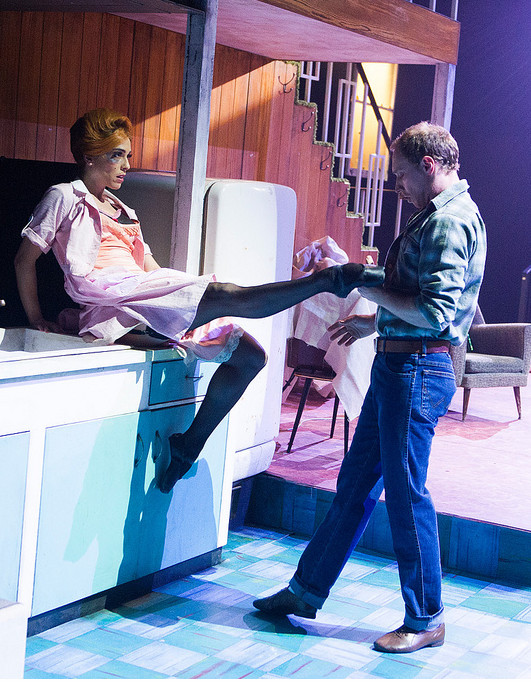Hansel and Gretel, Royal Ballet | reviews, news & interviews
Hansel and Gretel, Royal Ballet
Hansel and Gretel, Royal Ballet
Deeply disturbing dance drama is a powerful piece of theatre

"Be careful what you wish for," fairy tales teach us. After I wished in December for more bite in Scottish Ballet’s saccharine Hansel and Gretel, along comes this revival of Liam Scarlett’s 2013 version of the same story for the Royal Ballet. Depicting as it does child neglect, domestic violence, paedophilia, murder, psychosis and suicide, Scarlett’s Hansel and Gretel has bite all right.
Dark is an understatement here, in the black cavernous underground space of the Linbury Studio Theatre. Jon Bausor’s highly effective set bisects the stalls, bringing the audience right into Hansel and Gretel’s world – or rather, suggesting that their world is our world. The recorded score by Dan Jones is effective too, but less memorable. Mostly just sound-painting, it uses vaguely melodic strings and piano when the mood is gentle, clanging discordant percussion when things get scary, and occasional silences to showcase the dancers’ ragged panting.
 In a beat-up house in 1950s America, a worn, dead-eyed father – Bennet Gartside, gutsily raw – ignores his children, drinks, and fights with their vicious, louche, vulgar stepmother, danced by the utterly fabulous Laura Morera with electric venom (both pictured right). No surprise that wide-eyed Gretel (Leanne Cope), and naïf Hansel (James Hay) are not thriving in such a home environment – but their utter lack of security is revealed in chilling fashion (literally) when evil, in the shape of Donald Thom’s red-eyed Sandman, slithers right out of the refrigerator.
In a beat-up house in 1950s America, a worn, dead-eyed father – Bennet Gartside, gutsily raw – ignores his children, drinks, and fights with their vicious, louche, vulgar stepmother, danced by the utterly fabulous Laura Morera with electric venom (both pictured right). No surprise that wide-eyed Gretel (Leanne Cope), and naïf Hansel (James Hay) are not thriving in such a home environment – but their utter lack of security is revealed in chilling fashion (literally) when evil, in the shape of Donald Thom’s red-eyed Sandman, slithers right out of the refrigerator.
This hideously creepy character (pictured below left), with the plastic face, dirty white "combinations", and slouching hips of a soft-bodied rag doll, fascinates Hansel with his suggestive dancing. The children follow him into a twee, pink-curtained Wendy house, which in a fantastic coup de théâtre rises to reveal the utterly hellish dungeon beneath (I don’t think I have ever seen a set so immediately disturbing) into which Hansel and Gretel must descend. Here the Witch (Ryoichi Hirano), has twisted his tall frame into a child-sized plastic chair to hold a dolls’ tea party, while behind him a female body (his mother, it’s implied) lies head-first in an open oven, her bright red shoes mocking the idea that there’s no place like home. The pale-faced Witch is at first rigid and hesitant, then dangerously volatile; he is abetted in his sexual predation of Hansel by the Sandman, who we take to be some manifestation of his deranged mind.
 When – after escalating violence and sexual-emotional manipulation on all sides – Hansel and Gretel finally escape (leaving the Witch to a ragged, needy duet with the Sandman and a final encounter with his own gas oven), they find, in every child’s worst nightmare, that home is no longer there: their parents have sold up and left town. In the deserted house, Leanne Cope, whose honest, perceptive Gretel has hitherto been the most likeable character and the main candidate for any redemption going, suddenly channels her stepmother, casting off her coat in a carbon copy of Morera’s provocative contempt. With dawning horror, we realise that this really is no fairytale and no happy ending: these children are hideously damaged. As if it couldn’t get any darker, in the last moments they hang the Witch’s picture on the wall in place of their mother’s, and the Sandman creeps out of the Witch’s house, perhaps not a creature of the Witch’s mind after all but an independent agent of evil, off to make the world even worse.
When – after escalating violence and sexual-emotional manipulation on all sides – Hansel and Gretel finally escape (leaving the Witch to a ragged, needy duet with the Sandman and a final encounter with his own gas oven), they find, in every child’s worst nightmare, that home is no longer there: their parents have sold up and left town. In the deserted house, Leanne Cope, whose honest, perceptive Gretel has hitherto been the most likeable character and the main candidate for any redemption going, suddenly channels her stepmother, casting off her coat in a carbon copy of Morera’s provocative contempt. With dawning horror, we realise that this really is no fairytale and no happy ending: these children are hideously damaged. As if it couldn’t get any darker, in the last moments they hang the Witch’s picture on the wall in place of their mother’s, and the Sandman creeps out of the Witch’s house, perhaps not a creature of the Witch’s mind after all but an independent agent of evil, off to make the world even worse.
Though marrow-chilling, this ending rather weakens the story, hinting as it does that evil is a force separable from the human beings who perpetrate it. I suspect it’s a weak point of Scarlett’s approach more generally that, despite his obsession with darkness, he hasn’t got inside its mind yet. Evil is still a force external to his characters, who for all their emotional intensity are far from psychologically complex (in fact this lack of complexity probably explains their intensity, since it is much easier for dancers to project a few strong emotions than the turning wheels of troubled minds).
But these are minor reservations. I actually can’t help but recommend this wrenching piece of theatre enthusiastically to anyone with the guts for it. Scarlett has an undeniable gift for choreography in an elegant, flexible modern ballet idiom, and for inspiring tremendous peformances from his dancers. All six are physically superb in their roles, and all six hold nothing back; sweat flies, chairs are hurled, bottles smash over heads, and Donald Thom actually crawls over broken glass. All mere inches from the front row of the audience – seriously, the only way to get any closer to a Royal Ballet principal dancer is to be one yourself. If I hadn’t learned my lesson about wishing, I’d wish to see more new work, and lots of it, from everyone involved in this production.
- Hansel and Gretel is at the Linbury Studio Theatre, Royal Opera House, until 28 January
rating
Explore topics
Share this article
more Dance
 All You Need Is Death review - a future folk horror classic
Irish folkies seek a cursed ancient song in Paul Duane's impressive fiction debut
All You Need Is Death review - a future folk horror classic
Irish folkies seek a cursed ancient song in Paul Duane's impressive fiction debut
 MacMillan Celebrated, Royal Ballet review - out of mothballs, three vintage works to marvel at
Less-known pieces spanning the career of a great choreographer underline his greatness
MacMillan Celebrated, Royal Ballet review - out of mothballs, three vintage works to marvel at
Less-known pieces spanning the career of a great choreographer underline his greatness
 Carmen, English National Ballet review - lots of energy, even violence, but nothing new to say
Johan Inger's take on Carmen tries but fails to make a point about male violence
Carmen, English National Ballet review - lots of energy, even violence, but nothing new to say
Johan Inger's take on Carmen tries but fails to make a point about male violence
 WAKE, National Stadium, Dublin review - a rainbow river of dance, song, and so much else
THISISPOPBABY serves up a joyous tapestry of Ireland contemporary and traditional
WAKE, National Stadium, Dublin review - a rainbow river of dance, song, and so much else
THISISPOPBABY serves up a joyous tapestry of Ireland contemporary and traditional
 Swan Lake, Royal Ballet review - grand, eloquent, superb
Liam Scarlett's fine refashioning returns for a third season, and looks better than ever
Swan Lake, Royal Ballet review - grand, eloquent, superb
Liam Scarlett's fine refashioning returns for a third season, and looks better than ever
 First Person: Ten Years On - Flamenco guitarist Paco Peña pays tribute to his friend, the late, great Paco de Lucía
On the 10th anniversary of his death, memories of the prodigious musician who broadened the reach of flamenco into jazz and beyond
First Person: Ten Years On - Flamenco guitarist Paco Peña pays tribute to his friend, the late, great Paco de Lucía
On the 10th anniversary of his death, memories of the prodigious musician who broadened the reach of flamenco into jazz and beyond
 Dance for Ukraine Gala, London Palladium review - a second rich helping of international dancers
Ivan Putrov's latest gala was a satisfying mix of stars and young hopefuls
Dance for Ukraine Gala, London Palladium review - a second rich helping of international dancers
Ivan Putrov's latest gala was a satisfying mix of stars and young hopefuls
 Nelken: A Piece by Pina Bausch, Sadler's Wells review - welcome return for an indelible classic
A new generation of gifted performers for us to get to know
Nelken: A Piece by Pina Bausch, Sadler's Wells review - welcome return for an indelible classic
A new generation of gifted performers for us to get to know
 Dark With Excessive Bright, Royal Ballet review - a close encounter with dancers stripped bare
The Royal's Festival of New Choreography launches with an unforgettable walk in the dark
Dark With Excessive Bright, Royal Ballet review - a close encounter with dancers stripped bare
The Royal's Festival of New Choreography launches with an unforgettable walk in the dark
 La Strada, Sadler's Wells review - a long and bumpy road
Even the exceptional talents of Alina Cojocaru can't save dance adaptation of Fellini film
La Strada, Sadler's Wells review - a long and bumpy road
Even the exceptional talents of Alina Cojocaru can't save dance adaptation of Fellini film
 First Person: pioneering juggler Sean Gandini reflects on how the spirit of Pina Bausch has infiltrated his work
As Tanztheater Wuppertal Pina Bausch's 'Nelken' comes to Sadler’s Wells, a tribute from across the art forms
First Person: pioneering juggler Sean Gandini reflects on how the spirit of Pina Bausch has infiltrated his work
As Tanztheater Wuppertal Pina Bausch's 'Nelken' comes to Sadler’s Wells, a tribute from across the art forms
 Manon, Royal Ballet review - a glorious half-century revival of a modern classic
Fifty years on, Kenneth MacMillan's crash-and-burn anti-heroine is riding high
Manon, Royal Ballet review - a glorious half-century revival of a modern classic
Fifty years on, Kenneth MacMillan's crash-and-burn anti-heroine is riding high

Add comment